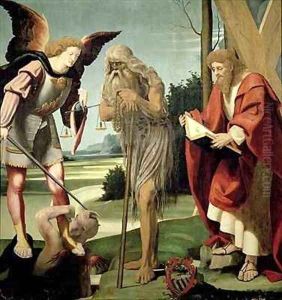Pseudo Bramantino Paintings
Pseudo Bramantino, an enigmatic figure in the landscape of Renaissance art, emerges as a distinctive voice amidst the creative fervor of 15th and 16th-century Italy. Not to be confused with Bramante or the Milanese painter and architect Bramantino (Bartolomeo Suardi), Pseudo Bramantino is a term art historians use to refer to an anonymous artist or group of artists whose works share stylistic similarities with those of the better-known Bramantino. The precise details of Pseudo Bramantino's life, including his real name, birthplace, and the extent of his oeuvre, remain shrouded in mystery, creating a fascinating puzzle for scholars.
The artist's approximate birth year is estimated to be around 1456, with his career spanning the late 15th and early 16th centuries, a period marked by the transition from the Late Gothic to the High Renaissance. The death of Pseudo Bramantino is similarly imprecise, believed to be around 1530. During this era, Milan and Lombardy were vibrant centers of artistic innovation, influenced significantly by the Sforza ducal court and its ambitious architectural and artistic projects. Pseudo Bramantino's work is characterized by a keen interest in architectural perspective, a nuanced use of light and shadow, and a distinctive approach to religious and mythological themes, suggesting a familiarity with the intellectual and artistic currents of his time.
The body of work attributed to Pseudo Bramantino includes frescoes, altarpieces, and drawings, marked by their meticulous attention to detail and a unique blend of northern Italian and Flemish influences. This blend is evident in the artist's sophisticated use of color and texture, as well as in the emotional depth and realism of his figures. One of the challenges in studying Pseudo Bramantino is the difficulty in distinguishing his work from that of Bramantino and other contemporaries, a task that requires careful analysis of stylistic and thematic elements.
Despite the challenges associated with his anonymity, Pseudo Bramantino's contributions to Renaissance art are increasingly recognized for their innovation and beauty. His works are seen as vital pieces of the broader narrative of Italian Renaissance art, reflecting the complex interplay of local traditions and broader European influences that characterized the period. As research continues, the figure of Pseudo Bramantino offers a compelling example of the mysteries that still animate the study of art history, inviting scholars to explore the depths of creativity that flourished in Renaissance Italy.
